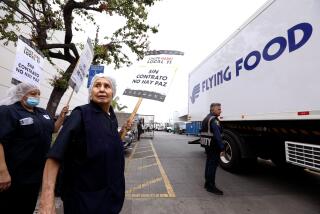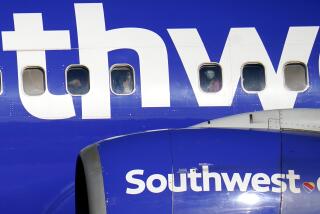Forward-Thinking Airline Recruitment Program Will Have ‘Empty Nesters’ Flying
FORT WORTH, Tex. — Six weeks ago, Jerry Hare stayed active in retirement by taking three-mile hikes on the plains near his west Texas home.
If he passes flight attendant school on Aug. 6, the 63-year-old Korean War veteran will be walking the planes of American Airlines instead.
Hare is American’s oldest flight attendant trainee, courtesy of a new program to recruit men and women older than 40 for its most visible cadre of workers.
“I think like young people. My wife says that’s what’s wrong with me,” Hare joked before going down an evacuation chute as part of his 5 1/2-week training.
American’s recruiters are trying to build the company’s employment reputation among 40- to 65-year-olds to get a jump on the demographic shift that will place the bulk of the population in that range within a decade.
Besides luring new workers, the program could generate goodwill--and extra business--among older travelers. That could be especially helpful now, as American and other airlines try to increase ridership after months of low bookings caused by the recession and the Persian Gulf War.
American’s program took off after a mention in the magazine of the American Assn. of Retired Persons this spring. More than 1,000 people sent letters of inquiry, 300 applied and several dozen have been or are now in training, said Frank Campagna, manager of flight attendant recruiting.
“We got a tremendous response,” Campagna said. “People were saying, ‘I thought the maximum age was 40. I had no idea that you could do this. I thought there was a legal age limit.’ ”
The airline’s only mandatory retirement is for pilots: age 60, as required by the government. Its oldest flight attendant, Juanita Carmichael of Margate Shores, Fla., turns 70 this fall. She joined the company in 1944.
American is one of a growing number of businesses to target older job candidates, said Emory Bullis, senior program specialist for AARP’s worker equity program.
One of the most visible is McDonald’s Corp., which featured an older worker in a TV commercial two years ago. McDonald’s now averages two to four older employees in each of its 8,600 U.S. outlets, McDonald’s spokeswoman Jane Maxwell said.
The former Piedmont Airlines, which merged with USAir two years ago, recruited older flight attendants for a short time with ads for “empty nesters,” or parents whose children had grown up and left home.
American’s largest competitors, United Airlines and Delta Air Lines, said they don’t have similar recruitment programs but welcome flight attendant candidates of all ages.
Older folks are a natural target as demographics change.
“We started doing analyses,” Campagna said. “From 1989 to 1991, we saw a doubling of the number of people in the mature candidate range, which we categorize as 40-plus.”
American says it gets about 54,000 applications for the 1,000 to 2,500 flight attendant jobs that open each year.
“But we have very high standards that we want these individuals to carry through into the aircraft with our customers,” Campagna said. “Whenever you have high standards, you’re going to have a higher rejection rate. We don’t want to be in the position six or seven years from now, when the demographics of our labor market changes, and say, ‘We should have thought about this.’ ”
American acknowledges some monetary advantages to its plan. A 55-year-old won’t accrue as much in pension benefits as a 22-year-old recruit who spends 40 years with the company.
But the average attendant stays with the airline seven years, and each year only a few workers retire with more than 30 years experience. More typical are those who leave after 20 years, taking a package of insurance, pension and travel benefits.
The older recruits, like all first-year attendants, get a salary and expense package of $18,300 a year. They’re also eligible for American’s health plan and fly stand-by for free on days off. Pensions kick in after five years, as with all American employees.
Training is also the same. Each must meet height and weight standards, and pass a physical and the training course. Housed in dormitories on American’s corporate campus near Dallas-Fort Worth International Airport, trainees are drilled in safety, service and appearance standards.
“Training has been more intense than I ever dreamed possible. I think that’s true with everybody,” Hare said as he waited to practice evacuations from a mock DC-10. “You put in 15, 16, 17 hours a day studying.”
For Bridget Richmond, a 53-year-old former hotel services manager from San Diego, the program ended “30 years of hoping and praying that one day I’d be up there.”
Her husband spotted the AARP magazine article. “He said, ‘That’s you. Go for it.’ And I went for it,” said the mother of six and grandmother of five.
“I don’t think my wife took it quite serious in the beginning. But she came right through now. She’s for traveling,” Hare said, noting that free travel perk.
Hare, a father of two and grandfather of three, joined the training program two years out of retirement, which he spent mostly reading, fishing, taking three-mile hikes and visiting his family in Texas. Before that, he’d spent 40 years in military and civilian posts with U.S. defense agencies, and was a mechanic and instructor for the Air Force in the Korean War.
It will be five years before he qualifies for an American pension. But retirement is the last thing on his mind.
“My father died at 94. My mother’s 93 and still alive,” he said. “I stay active. They say, keep your wheels in motion.”
More to Read
Sign up for Essential California
The most important California stories and recommendations in your inbox every morning.
You may occasionally receive promotional content from the Los Angeles Times.









